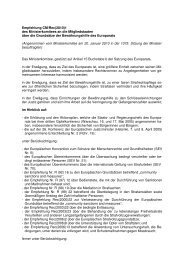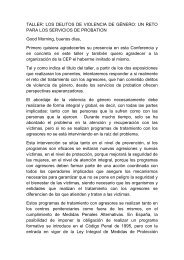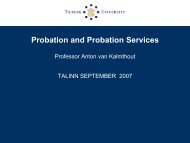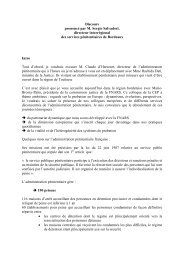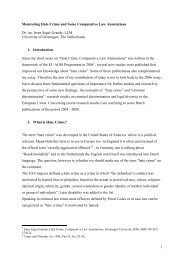Report EM 2005 - E - CEP, the European Organisation for Probation
Report EM 2005 - E - CEP, the European Organisation for Probation
Report EM 2005 - E - CEP, the European Organisation for Probation
You also want an ePaper? Increase the reach of your titles
YUMPU automatically turns print PDFs into web optimized ePapers that Google loves.
He <strong>the</strong>n explained how <strong>the</strong> technology worked. Tracking used objects such as satellites<br />
or radio masts which transmitted signals containing time and location data. The offender<br />
carried a personal tracking device which received satellite or o<strong>the</strong>r signals and calculated<br />
its own location. The tracking device transmitted location data to a control centre ei<strong>the</strong>r<br />
in real time (active tracking), or retrospectively (passive tracking) or some combination<br />
of <strong>the</strong> two (hybrid tracking).<br />
He said that in active tracking, <strong>the</strong> tracking device contained GSM or GPRS technology<br />
allowing <strong>the</strong> immediate transmission of location data. This enabled a quick response to<br />
violations, but with higher telecommunications costs and possibly additional staff costs<br />
depending on <strong>the</strong> procedures used.<br />
In passive tracking, <strong>the</strong> location data was not transmitted in real time but was stored<br />
and transmitted retrospectively when <strong>the</strong> tracking device was attached to a telephone<br />
line. This was cheaper to operate, but <strong>the</strong> location data was generally not available to<br />
supervisors until <strong>the</strong> next day.<br />
And in hybrid tracking, <strong>the</strong> tracking device was capable of behaving in active mode, but<br />
as long as <strong>the</strong> offender was compliant <strong>the</strong> device behaved in passive mode and<br />
transmitted data retrospectively. If <strong>the</strong> offender violated <strong>the</strong> tracking conditions, <strong>for</strong><br />
example by entering a prohibited area, <strong>the</strong> tracking device would transmit <strong>the</strong> violation<br />
in real time and would switch to active mode until <strong>the</strong> violation was cleared.<br />
Whatever <strong>the</strong> mode of transmission, <strong>the</strong> end product was a detailed map showing <strong>the</strong><br />
offender’s movements while tracked.<br />
Turning to <strong>the</strong> uses of tracking, he said that its most obvious application was to monitor<br />
compliance with specific requirements, <strong>for</strong> example to observe a curfew, stay out of an<br />
exclusion zone, or attend specified programmes or o<strong>the</strong>r activities. The supervisor could<br />
fill <strong>the</strong> offender’s schedule with requirements and monitor <strong>the</strong>m all using tracking.<br />
Tracking could in <strong>the</strong>ory be used to watch an offender’s movements all <strong>the</strong> time, as <strong>the</strong>y<br />
happen. But if it was necessary to know where people were 24 hours a day, surely <strong>the</strong>y<br />
should be in prison anyway. And to have one person watching a screen all day would be<br />
extremely staff-intensive.<br />
Alternatively, location data could be useful to suppliers in managing offender<br />
programmes. The data could be useful to <strong>the</strong> police in confirming offender involvement<br />
in o<strong>the</strong>r crimes – or eliminating <strong>the</strong>m from <strong>the</strong> investigation. And <strong>the</strong> sense of being<br />
watched might potentially deter offenders from fur<strong>the</strong>r crimes.<br />
He <strong>the</strong>n discussed some of <strong>the</strong> issues arising from tracking. First, <strong>the</strong> tracking device.<br />
This clearly had to stay with <strong>the</strong> offender <strong>for</strong> <strong>the</strong> duration of <strong>the</strong> tracking. This could be<br />
achieved with ei<strong>the</strong>r a one-piece or a two-piece device. Each solution had its advantages<br />
and disadvantages.<br />
10


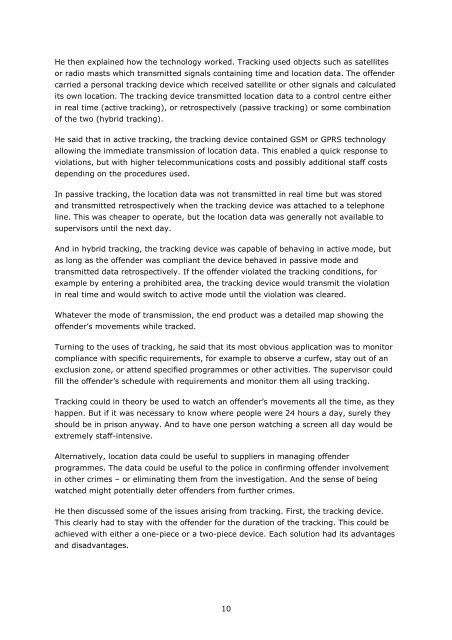

![AGIS2 Nov 08 Conference Report_[Version 2] - CEP, the European ...](https://img.yumpu.com/50764570/1/190x245/agis2-nov-08-conference-report-version-2-cep-the-european-.jpg?quality=85)
